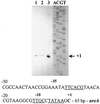Analysis of urease expression in Actinomyces naeslundii WVU45
- PMID: 11083780
- PMCID: PMC97765
- DOI: 10.1128/IAI.68.12.6670-6676.2000
Analysis of urease expression in Actinomyces naeslundii WVU45
Abstract
The hydrolysis of urea by ureases of oral bacteria in dental plaque can cause a considerable increase in plaque pH, which can inhibit the development of dental caries. There is also indirect evidence that urea metabolism may promote the formation of calculus and that ammonia release from urea could exacerbate periodontal diseases. Actinomyces naeslundii, an early colonizer of the oral cavity and a numerically significant plaque constituent, demonstrates comparatively low levels of urease activity on isolation, so this organism has not been considered a major contributor to total oral urease activity. In this study it was observed that urease activity and urease-specific mRNA levels in A. naeslundii WVU45 can increase up to 50-fold during growth under nitrogen-limiting conditions. Using primer extension analysis, a putative, proximal, nitrogen-regulated promoter of the A. naeslundii urease gene cluster was identified. The functionality and nitrogen responsiveness of this promoter were confirmed using reporter gene fusions and 5' deletion analysis. The data indicated that regulation of urease expression by nitrogen availability in A. naeslundii may require a positive transcriptional activator. Plaque bacteria may experience nitrogen limitation when carbohydrates are present in excess. Therefore, based on the results of this study and in contrast to previous beliefs, strains of A. naeslundii may have the potential to be significant contributors to total plaque ureolysis, particularly during periods when there is an increased risk for caries development.
Figures



Similar articles
-
Genetic and physiologic characterization of urease of Actinomyces naeslundii.Infect Immun. 1999 Feb;67(2):504-12. doi: 10.1128/IAI.67.2.504-512.1999. Infect Immun. 1999. PMID: 9916052 Free PMC article.
-
Characterization of the Actinomyces naeslundii ureolysis and its role in bacterial aciduricity and capacity to modulate pH homeostasis.Microbiol Res. 2006;161(4):304-10. doi: 10.1016/j.micres.2005.11.002. Epub 2006 Jan 18. Microbiol Res. 2006. PMID: 16412620
-
Regulation of urease expression of Actinomyces naeslundii in biofilms in response to pH and carbohydrate.Oral Microbiol Immunol. 2008 Aug;23(4):315-9. doi: 10.1111/j.1399-302X.2008.00430.x. Oral Microbiol Immunol. 2008. PMID: 18582331
-
Glucose and lactate metabolism by Actinomyces naeslundii.Crit Rev Oral Biol Med. 1999;10(4):487-503. doi: 10.1177/10454411990100040501. Crit Rev Oral Biol Med. 1999. PMID: 10634585 Review.
-
Bacterial ureases: structure, regulation of expression and role in pathogenesis.Mol Microbiol. 1993 Sep;9(5):907-13. doi: 10.1111/j.1365-2958.1993.tb01220.x. Mol Microbiol. 1993. PMID: 7934918 Review.
Cited by
-
Rapid urease test (RUT) for evaluation of urease activity in oral bacteria in vitro and in supragingival dental plaque ex vivo.BMC Oral Health. 2018 May 18;18(1):89. doi: 10.1186/s12903-018-0541-3. BMC Oral Health. 2018. PMID: 29776416 Free PMC article.
-
The effect of sucrose on plaque and saliva urease levels in vivo.Arch Oral Biol. 2010 Mar;55(3):249-54. doi: 10.1016/j.archoralbio.2009.12.007. Epub 2010 Jan 21. Arch Oral Biol. 2010. PMID: 20096398 Free PMC article.
-
Urease activity in dental plaque and saliva of children during a three-year study period and its relationship with other caries risk factors.Arch Oral Biol. 2011 Nov;56(11):1282-9. doi: 10.1016/j.archoralbio.2011.04.015. Epub 2011 May 26. Arch Oral Biol. 2011. PMID: 21616477 Free PMC article.
-
Bioprospecting of Metabolites from Actinomycetes and their Applications.Recent Pat Biotechnol. 2024;18(4):273-287. doi: 10.2174/0118722083269904231114154017. Recent Pat Biotechnol. 2024. PMID: 38817008 Review.
-
The Pathogenic Role of Actinomyces spp. and Related Organisms in Genitourinary Infections: Discoveries in the New, Modern Diagnostic Era.Antibiotics (Basel). 2020 Aug 17;9(8):524. doi: 10.3390/antibiotics9080524. Antibiotics (Basel). 2020. PMID: 32824418 Free PMC article. Review.
References
Publication types
MeSH terms
Substances
Grants and funding
LinkOut - more resources
Full Text Sources
Other Literature Sources
Molecular Biology Databases

